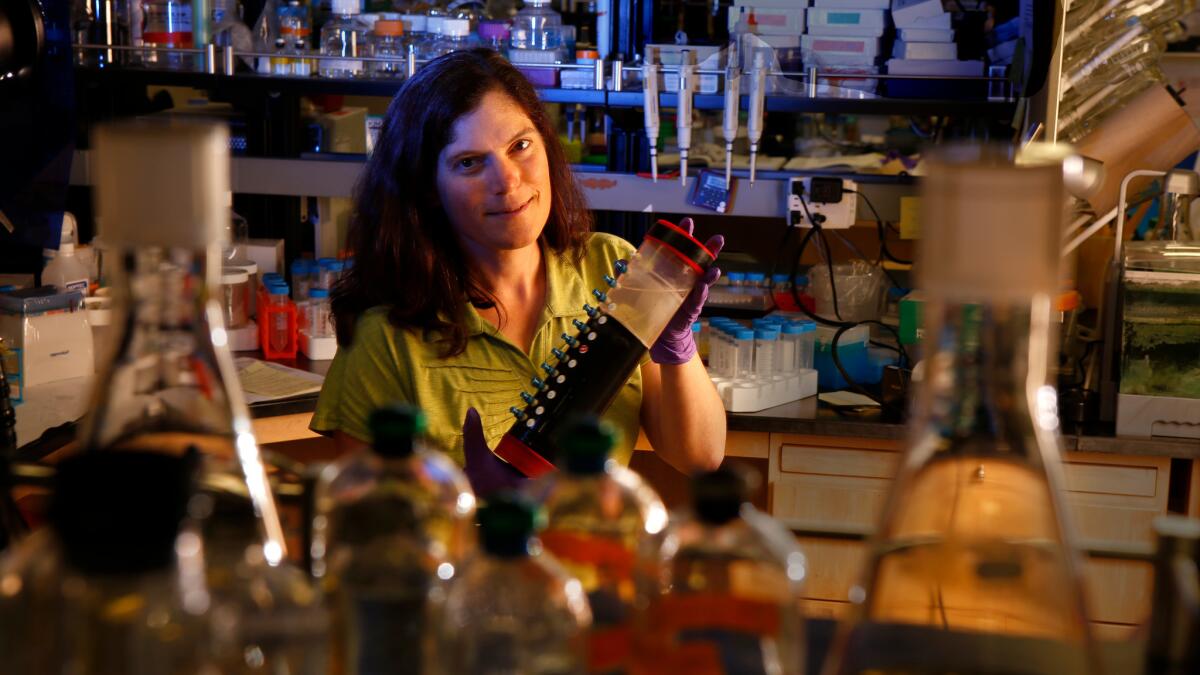MacArthur winner Victoria Orphan showed how deep-sea microbes keep greenhouse gas out of the atmosphere

Victoria Orphan was on a boat off the Southern California coast in 1993 when she asked a graduate student sampling seawater about his research. He stained a sample with fluorescent dye and put it under a microscope. Orphan, then a UC Santa Barbara undergraduate, stared at the dense constellations of glowing microbes.
“It was like looking at the Milky Way,” she said. “It was just an incredible amount of microscopic life. I’ve never looked at a glass of seawater the same way since.”
That was the beginning of a path that put Orphan on the list of 2016 MacArthur fellows. The award comes with a $625,000 no-strings-attached “genius grant” meant to encourage creative scientists, artists and other thinkers who are pushing the boundaries of their fields.
Orphan, now a geobiologist at Caltech, certainly fits that bill: She has used her expertise in microbiology and geochemistry to study the often-surprising ways that microbes interact with, and alter, the world around them. The questions she’s probing could have implications for climate science, the history of life on early Earth and even the search for life on other planets.
“She is the glue of geobiology,” said Caltech geologist John Grotzinger, former project scientist for NASA’s Mars Curiosity rover. Orphan’s particular set of skills, he added, “helps our program stay very strong at the interface between ancient Earth and modern Earth, as viewed through the lens of microbial ecology.”
The San Diego native has always felt a deep connection to the sea. As a kid, she had her bedroom wall painted blue like the ocean; she and her friends added fish and — near the ceiling — the bottom of a boat. The effect was of living in a human-sized aquarium.
Now the scientist roams the ocean, collecting and testing samples of microscopic organisms that live in its depths at crushing pressures — some at boiling underwater vents and others in frigid darkness. Tiny as these microbes are, Orphan has shown again and again the profound role these creatures have played in shaping the chemistry and geology of Earth.

MacArthur winner Victoria Orphan showed how deep-sea microbes keep greenhouse gas out of the atmosphere.
Much of the roughly 4-billion-year history of life has been dominated by microorganisms that have sculpted the environment into a livable planet for the animals and planets we see today — including us.
“These microorganisms are basically life support,” Orphan said.
Microbes exhaled oxygen into the atmosphere, providing air to breathe long before plants and trees evolved. Some fix molecular nitrogen, converting it into a form that other organisms can use. And as Orphan’s work has shown, some microbes help keep the greenhouse gas methane out of the atmosphere, storing it in carbonate rocks deep in the ocean. (While methane is not as prevalent in the atmosphere as carbon dioxide, it is far more effective at trapping heat.)
But studying these tiny bacteria and Archaea (another ancient microbe lineage) is no easy task. They thrive in remote, inaccessible places, which makes them difficult to retrieve. Unless scientists repeatedly return to sample the same spot, they probably won’t see how a diverse microbial community changes over time. And even if scientists recreate the high-pressure conditions of their natural environment in the lab, there’s no way to tell for sure whether microbes are acting the way they would in nature.
Orphan tackled these and other problems with ingenious and creative solutions. She would visit a deep-ocean microbe community again and again, introducing food sources with isotopic tracers that allowed her to follow the nutrients’ movement through the population over time. She also used nanoscale secondary ion mass spectroscopy — a tool typically employed to study materials, not microorganisms — to see how the various factions of microbes were interacting with each other, producing and sharing resources in complex ways.
“She just has a natural curiosity,” said Shana Goffredi, Orphan’s life partner and a biologist at Occidental College who studies symbioses between animals and bacteria. “She just runs through obstacles.”
Orphan studies a diverse array of questions surrounding these microbes. She has watched how their populations spike after a whale dies and its carcass hits the ocean floor, becoming a decades-long smorgasbord and introducing new resources into nutrient-starved communities. She is trying to understand the symbiotic relationships between different species that seem to pass electrons between each other, as if on conductive wires.
Understanding these extremophiles and the geochemical footprints they leave behind in the rock could also shed light on the hunt for alien life on planets such as Mars.
Orphan’s ability to pursue all these different directions in her small but growing field may be thanks in part to her talents as a collaborator, those who know her say.
“It’s important to diversify your life in terms of the scientists you interact with across different fields,” she said. “This leads to discoveries in unexpected ways.”
Follow @aminawrite on Twitter for more science news and “like” Los Angeles Times Science & Health on Facebook.
MORE IN SCIENCE
Manu Prakash, newly minted MacArthur ‘genius,’ builds water computers and origami microscopes
MacArthur Fellow Jin-Quan Yu breaks some of nature’s strongest bonds to synthesize new molecules




